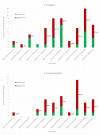Hospital and Population-Based Evidence for COVID-19 Early Circulation in the East of France
- PMID: 33007976
- PMCID: PMC7579479
- DOI: 10.3390/ijerph17197175
Hospital and Population-Based Evidence for COVID-19 Early Circulation in the East of France
Abstract
Background: Understanding SARS-CoV-2 dynamics and transmission is a serious issue. Its propagation needs to be modeled and controlled. The Alsace region in the East of France has been among the first French COVID-19 clusters in 2020.
Methods: We confront evidence from three independent and retrospective sources: a population-based survey through internet, an analysis of the medical records from hospital emergency care services, and a review of medical biology laboratory data. We also check the role played in virus propagation by a large religious meeting that gathered over 2000 participants from all over France mid-February in Mulhouse.
Results: Our results suggest that SARS-CoV-2 was circulating several weeks before the first officially recognized case in Alsace on 26 February 2020 and the sanitary alert on 3 March 2020. The religious gathering seems to have played a role for secondary dissemination of the epidemic in France, but not in creating the local outbreak.
Conclusions: Our results illustrate how the integration of data coming from multiple sources could help trigger an early alarm in the context of an emerging disease. Good information data systems, able to produce earlier alerts, could have avoided a general lockdown in France.
Keywords: COVID-19; SARS-Cov-2; emerging infectious disease; epidemic surveillance; epidemic threshold.
Conflict of interest statement
The authors declare that there is no conflict of interest.
Figures







References
-
- WHO Director-General’s Opening Remarks at the Media Briefing on COVID-19—11 March 2020. [(accessed on 4 August 2020)]; Available online: https://www.who.int/dg/speeches/detail/who-director-general-s-opening-re....
-
- Bernard Stoecklin S., Rolland P., Silue Y., Mailles A., Campese C., Simondon A., Mechain M., Meurice L., Nguyen M., Bassi C., et al. First cases of coronavirus disease 2019 (COVID-19) in France: Surveillance, investigations and control measures. Euro Surveill. 2020;25 doi: 10.2807/1560-7917.ES.2020.25.6.2000094. - DOI - PMC - PubMed
-
- Fontanet A., Tondeur L., Madec Y., Grant R., Besombes C., Jolly N., Fernandes Pellerin S., Ungeheuer M.-N., Cailleau I., Kuhmel L., et al. Cluster of COVID-19 in northern France: A retrospective closed cohort study. Medrxiv. 2020 doi: 10.2139/ssrn.3582749. - DOI
-
- Press Release from Haut-Rhin Prefecture. [(accessed on 4 August 2020)]; Available online: http://www.haut-rhin.gouv.fr/content/download/29866/184044/file/CP_Coron....
MeSH terms
LinkOut - more resources
Full Text Sources
Miscellaneous

